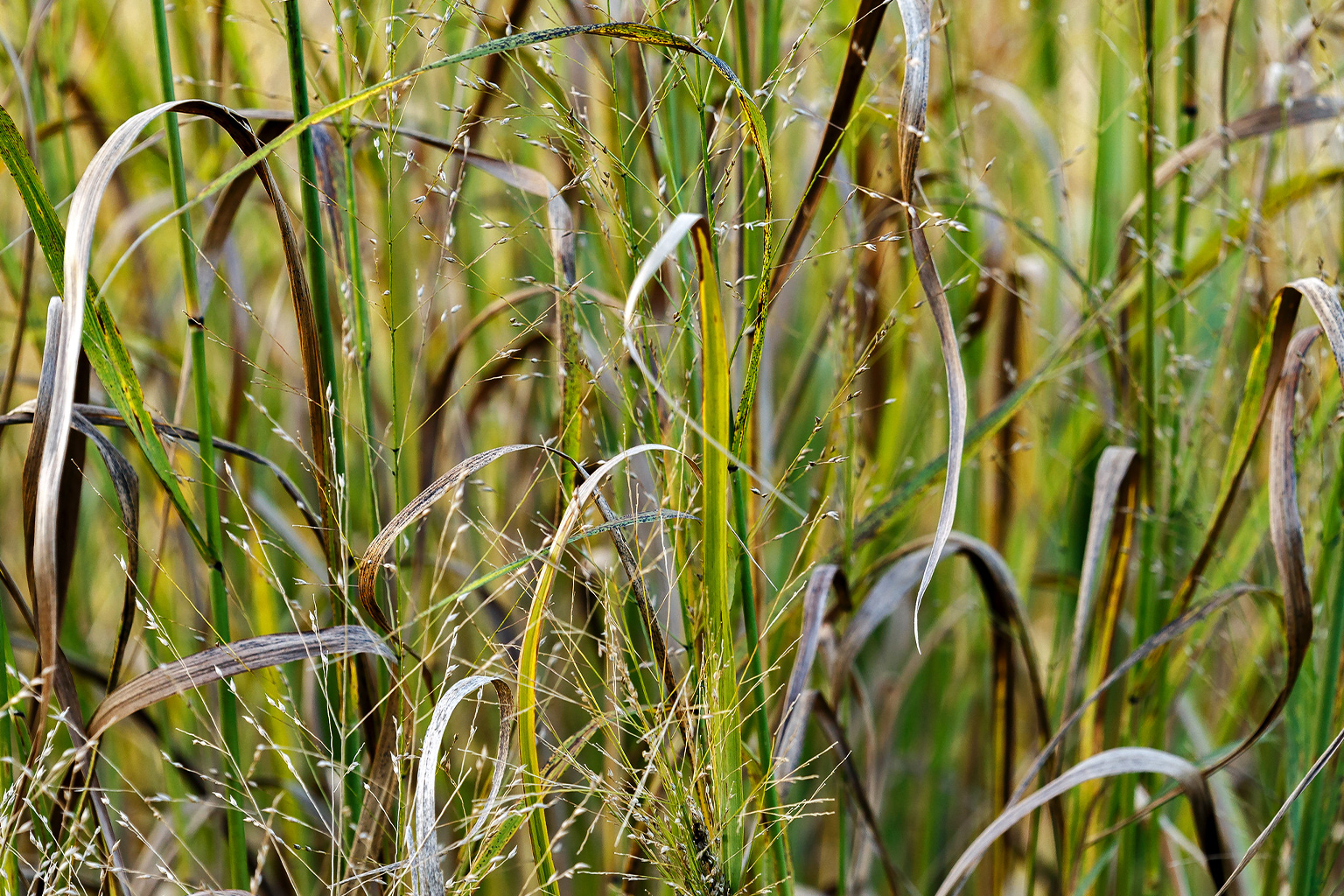- Several kinds of grasses and woody shrubs, such as poplar and willow, have undergone U.S. testing for years to see if they can achieve high productivity as cellulose-based liquid biofuels for cutting greenhouse gas emissions in the global transportation sector. Some of these grasses also would have value as cover crops.
- While these experiments showed promise, the challenges for scaling up production of grass and woody shrub-derived biofuels over the next few decades remain significant. And time is short, as climate change is rapidly accelerating.
- Another roadblock to large-scale production: Millions of acres of land in the U.S. Southeast and Great Plains states would need to be earmarked for grass cultivation to make it economically and commercially viable as a biofuel.
- If many of those millions of acres required conversion of natural lands to agriculture, then deforestation and biodiversity loss due to biofuel monoculture crop expansion could be a major problem. On the plus side, grass biofuel crops likely wouldn’t directly displace food crops, unlike corn to make ethanol, or soy to make biodiesel.
Large-scale efforts to seriously curb reliance on fossil fuels for global energy needs, especially in the transportation sector, are leading scientists, farmers, policymakers and environmentalists to consider numerous liquid biofuel alternatives in energy production.
A few biofuels, such as ethanol made from corn, and biodiesel made from soy, are already in use, where 10-20% of the fuel mix at the gas pump is bio-based. Other potential, but more exotic, biofuels, including those made from algae and organic waste, are moving from a decades-long research phase slowly toward development — as the energy industry now confronts the big challenges of scaling up production to meet large-scale global needs.
But another potential energy source not benefiting from the media fanfare that has accompanied the turning of algae or poop into fuel, is grass. Grasses cover large swaths of the Earth, are relatively easy to grow, and can sometimes serve dual roles as agricultural cover crop and liquid fuel source.
Several types of plants and grasses such as sorghum, Miscanthus or Chinese silvergrass, Panicum virgatum or switchgrass, as well as hybrid strains of fast-growing poplar and willow woody shrubs are currently being tested at research and university facilities across the United States in the hope they will one day be major cellulose-based biofuel players.
Gerald Tuskan, director at the Center for Bioenergy Innovation (CBI) at Oak Ridge National Laboratory in Tennessee, says a sea of switchgrass grown in the U.S. Great Plains might be the key to unlocking a sustainable aviation fuel in the next 20 to 30 years.
“We are using a combination of biology and chemistry to get to an aviation fuel,” he said, commenting on the facility’s pioneering work with switchgrass. “We [already] know we can do this in a lab, or out in a plot in a field, but the challenge we are facing is scaling up.”
Scaling up isn’t the only hurdle facing grass and woody shrub biomass-derived fuels: Environmental factors figure into their development. The vast amounts of land needed to make sufficient biofuel to meet global demand raises serious deforestation and biodiversity questions. And because monocultures lack genetic diversity, there’s a greater chance of disease and also insect infestations as plantings turn more pesticide resistant. While most grasses tested use minimal water, fertilizers used to boost crop yields could affect water quality.

The search for champion grass feedstock
Since the mid-1970s, the U.S. has funded research for what Tuskan calls “herbaceous energy crops,” including grasses such as Miscanthus, an ornamental plant often grown in gardens and used in landscaping due to its low maintenance — an advantage for biofuel use as well. Grasses have other pluses as fuels: They grow quickly and are perennials, so annual replanting isn’t needed. Some can serve as both agricultural cover crop and fuel.
After years of experimentation, four or five grass types have been identified as being the most likely to become economically viable liquid fuels in a few decades. These have entered further testing and hybridization. Today, scientists are continuing to evaluate grass and woody shrub genotypes for disease resistance, drought tolerance, nutrient use efficiency, and high energy productivity.
“We’re [practicing] the same principles used in corn breeding in creating hybrid willows and hybrid poplars to achieve [high] growth rates and [high biofuel productivity] targets,” said Tuskan, regarding tests of cellulose feedstock for sustainable aviation fuels (SAFs).
These hybridization efforts include sweeping studies over vast areas to map plant genomes to find and learn more about the best biofuel candidates. The CBI, for example, launched a genome-wide association study across the natural range of switchgrass, from northern Mexico to the Canadian border, and assembled about 400 unique genotypes of switchgrass. Then it genetically sequenced and annotated them to generate the complete genome of individual species. From there, scientists can select varieties with desired traits for breeding.

Scientists at Oak Ridge Lab are currently managing four gardens for breeding and testing switchgrass: three in Georgia and one in Tennessee. All have been growing for six years, and are expected to produce for another four, providing 10 years of field data. Other university programs, such as those at the University of Texas, and Austin’s Brackenridge Field Lab are testing switchgrass in experimental gardens.
But despite all this research, the United States is not currently producing grass biofuels at a commercial level, according to an emailed statement sent to Mongabay by a U.S. Environmental Protection Agency official.
In fact, industry has shown signs of giving up the effort. Abengoa, a U.S. bioenergy company, shuttered its cellulosic ethanol plant in Hugoton, Kansas. And POET Bioprocessing — which sought to first make ethanol from corn stalks, then shifted to high-yield perennials like switchgrass — closed its plant in Emmetsburg, Iowa, according to Doug Rivers, executive vice president and project director of Lee Enterprises Consulting, a bioeconomy consultancy based in Arkansas.
“Neither achieved the levels of conversion or consistency required at commercial scale,” he explained in a statement emailed to Mongabay.
Likewise, a DuPont cellulose-based ethanol plant in Nevada, Iowa; it never opened and was sold to a German firm, Verbio, which converted the facility to produce natural gas.
“The technology to convert grasses to biofuel is still relatively nascent, expensive, and inefficient in producing biofuels from grass, so it’s not economical,” said the EPA official.

Getting to scale: It’s complicated
One of the largest hurdles in grass biofuel creation is that the conversion process is scientifically complex, whether in the lab or when scaling up to commercial levels. “These types of grasses can be good producers of fuel, but no cellulosic biomass can compete with corn starch or cane sugar, as they have a more concentrated source of sugars that are accessed much more easily,” said Rivers.
“Herbaceous biomass represents lignocellulose, which is very different from the corn to ethanol industry,” explained Tuskan. “In the current ethanol industry, the corn is grown, and the kernel is harvested, and starch is extracted and then that starch is fermented into ethanol.”
But with herbaceous plants such a switchgrass, Tuskan continued, cell wall components are used. And “you have to be able to easily deconstruct that cell wall to get to the sugars that are contained in the cellulose. We have a [CBI] team developing these conversion platforms, where we can take this recalcitrant, difficult to deconstruct material and then produce biofuels.”

A study by Michigan State University researchers published in Frontiers of Plant Science in January, found another potentially major problem with large-scale grass biofuel production. Switchgrass, they said, sometimes stops photosynthesis during its prime growing season, limiting its fuel potential, due to its rhizomes storing starch and signaling to the plant to stop adding biomass. Further research could yield a better understanding of this switchgrass growth behavior and lead to a hybrid breeding solution, the scientists concluded.
Rivers related his experience with switchgrass at demonstration facilities at ICM, Inc. in Colwich, Kansas, and in St. Joseph, Missouri, from 2012 to 2015. Those efforts converted about 70% of available cellulose and hemicellulose to sugars fermented to ethanol, in a fully integrated 10 dry ton/day feedstock. “At that demonstration scale approximately 60 gallons [227 liters] of ethanol were produced per ton of switchgrass,” he reports.
But more problems loom: Converting grass into SAFs requires additional steps, Tuskan explained: To create the three primary components of jet fuel — isoparaffins, cycloparaffins, and aromatics — cellulose needs to be fermented to “an intermediate that would be catalytically upgraded.” But, as ever, scaling up to commercial levels remains elusive.
“The primary need for scalability is a commercially successful process capable of operating [nearly continuously] and producing products such as ethanol, single cell protein, and lignin-based co-products that provide a reasonable financial return on the capital investment,” said Rivers. “I am not aware of anyone that has done that.”
Practical challenges at the processing level somewhat unique to grasses also thwart scaling up: A reliable supply of about 700 dry tons per day of grass feedstock is required to produce 25 million gallons (95 million liters) of ethanol a year, said Rivers. “That is not only a feedstock production challenge, but it is also a complete supply chain logistics challenge.”

According to Rivers, bales of dry grass have a low bulk density compared to corn feedstock, meaning a ton of the former would take up far more cargo space than a ton of the latter. They’re also more difficult to handle at the processing facility. Corn flows similarly to water; biomass doesn’t.
Storage of seasonal grass feedstocks is also an issue: “Bales of dry grass can and do burn, and fires have been a challenge in past commercial attempts,” Rivers said. “These feedstocks are also more abrasive than one might expect. Their use produces accelerated equipment wear, specifically at the front end of a process before they are hydrolyzed to fermentable sugars used to produce ethanol or other fermentation products.”
And of course, the amount of land needed to grow all that grass is considerable. The Southeast U.S. and Great Plains states are considered the best regions for grass biofuel cultivation. But there may not be enough marginal lands there (lands with poor soil and insufficient water to raise food crops) to plant the gigantic amounts of grass needed.
To entirely replace conventional jet fuel by 2050, grasses would need to provide 35 billion gallons (132 billion liters)of fuel annually, which translates to about 20 million acres (8 million hectares) of land in cultivation, Tuskan said. “It’s not all going to be in Alabama, or western South Dakota,” he said. “That’s why we have a portfolio of [grass] species [to be made into biofuel], because they [need to be] adapted locally to those environments.”
Then there are the environmental risks of using these so-called marginal lands to plant vast grass monocultures, which could cause deforestation and displace native species of plants and animals. While second-generation biofuel crops such as switchgrass aren’t as destructive to habitat as oil palm or corn, studies have shown the land use for biofuel crop cultivation reduces local biodiversity, especially native plants and vertebrate species.
On the plus side, some biodiversity benefits have been found for woody and herbaceous crops including poplar and willow (which can increase invertebrate abundance, providing food for birds), while perennial grasses can imitate native grasslands and offer habitat for migratory birds.

A race against the clock
Even researchers and companies with large resources and state-of-the-art technology are finding grass biofuel scalability very difficult to achieve, especially when it comes to one key element: Time.
“I believe that grass feedstocks such as switchgrass and Miscanthus do have potential as viable feedstocks for the production of biofuels,” said Rivers. “However, there are significant barriers that remain to be solved … The primary obstacles are incentives to plant these grasses, and the more critical need for a combined technically and economically successful conversion process at commercial scale.”
Simply put: Barring a sudden major technological breakthrough, the protracted development of an economically viable and scalable grass biofuel is being outpaced by the intensifying scale of global carbon emissions and rapidly escalating climate change. Global warming “is one of the largest problems confronting us today,” said Tuskan. “There could be dramatic changes in how we live if we aren’t able to reduce CO2 emissions in the next 20 or 30 years.
“We have 260 Ph.D. scientists [at CBI] working on this problem,” he said. “Anything we can do to reduce CO2 in the atmosphere will ultimately benefit future generations. Everybody involved in the project recognizes that, and is working very, very hard to make it a reality.
Banner image: Panicum virgatum or switchgrass is one of several types of grasses and woody shrubs currently being tested at research and university facilities across the United States in the hope they will one day be major cellulose-based biofuel players. Image by Will Parson/Chesapeake Bay Program via Flickr (CC BY-NC 2.0).
FEEDBACK: Use this form to send a message to the author of this post. If you want to post a public comment, you can do that at the bottom of the page.
Jatropha: The biofuel that bombed seeks a path to redemption
Citations:
Volk, T. A., Berguson, B., Daly, C., Halbleib, M. D., Miller, R., Rials, T. G., … Wright, J. (2018). Poplar and shrub willow energy crops in the United States: Field trial results from the multiyear regional feedstock partnership and yield potential maps based on the PRISM‐ELM model. GCB Bioenergy, 10(10), 735-751. doi:10.1111/gcbb.12498
Tibbs Cortes, L., Zhang, Z., & Yu, J. (2021). Status and prospects of genome‐wide association studies in plants. The Plant Genome, 14(1). doi:10.1002/tpg2.20077
Tejera-Nieves, M., Abraha, M., Chen, J., Hamilton, S. K., Robertson, G. P., & Walker, B. J. (2023). Seasonal decline in leaf photosynthesis in perennial switchgrass explained by sink limitations and water deficit. Frontiers in Plant Science, 13. doi:10.3389/fpls.2022.1023571
Tudge, S. J., Purvis, A., & De Palma, A. (2021). The impacts of biofuel crops on local biodiversity: A global synthesis. Biodiversity and Conservation, 30(11), 2863-2883. doi:10.1007/s10531-021-02232-5
FEEDBACK: Use this form to send a message to the author of this post. If you want to post a public comment, you can do that at the bottom of the page.































